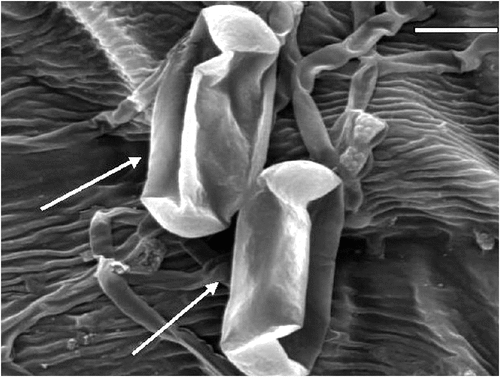First report of powdery mildew caused by Podosphaera sp. on Hibiscus sabdariffa in India
Pankaj Baiswar A C , Satish Chandra A , Rajesh Kumar B , S. V. Ngachan A and G. C. Munda BA Division of Plant Pathology, ICAR Research Complex for NEH Region, Umiam-793103, Meghalaya, India.
B Division of Agronomy, ICAR Research Complex for NEH Region, Umiam-793103, Meghalaya, India.
C Corresponding author. Email: pbaiswar@yahoo.com
Australasian Plant Disease Notes 5(1) 123-125 https://doi.org/10.1071/DN10045
Submitted: 8 March 2010 Accepted: 2 November 2010 Published: 29 November 2010
Abstract
Powdery mildew was observed on Hibiscus sabdariffa during October 2009. Calyces and leaves of this plant are used as an ingredient in preparation of non-vegetarian food in the north-eastern hills region of India. Light and scanning electron microscopy revealed the presence of the anamorph of Podosphaera. This is the first report of powdery mildew on H. sabdariffa caused by Podosphaera sp. in India.
Tribal populations in north-east India uses calyces and leaves of Hibiscus sabdariffa as ingredients in preparation of non-vegetarian food. Beverages derived from H. sabdariffa are called hibiscus tea, roselle, red sorrel, agua de Jamaica, Lo-Shen, Sudan tea, sour tea and karkade. It helps in lowering blood pressure in prehypertensive and mildly hypertensive adults (McKay et al. 2010). Flowers and seeds of H. sabdariffa are also considered as purifiers of blood and liver (Lans 2006). It is also used for production of bast fibre in India (Das and Das 2000).
Powdery mildew-infected plants were observed in Barapani, Meghalaya, India during October 2009. Disease symptoms included whitish circular patches on the upper surfaces of the leaves (Fig. 1). Symptoms were present on mature leaves. Voucher specimens have been deposited in the herbarium collections of MACS Agharkar Research Institute, Pune and ICAR Research Complex for NEH Region, India (AMH No. 9324, ICARHNEH-116).

|
For light microscopy a strip of clear tape was used to dislodge mycelia and conidia from the infected tissue (Correll et al. 1987). In scanning electron microscopy (SEM) suitable areas were selected using a dissecting microscope. Leaf areas containing powdery growth were cut and placed on double-sided cellotape then sputter coated with gold using Fine coat ion sputter JFC –1100 (JEOL, Tokyo, Japan). Gold-coated samples were then placed on aluminium stubs in a JEOL JSM 6360 SEM (JEOL, Tokyo, Japan). Characters examined were the surface pattern of conidia, presence or absence of appressoria and type of appressoria.
Previously, Erysiphe, Golovinomyces, Podosphaera and Leveillula have been reported on Hibiscus. L. taurica and E. euphorbicola have been reported on H. sabdariffa (Farr and Rossman 2009). Our observations revealed the presence of ectophytic mycelium, conidia in chains, fibrosin bodies and indistinct appressoria, which indicated Podosphaera and excluded the possibility of Erysiphe, Golovinomyces and Leveillula (Braun et al. 2002). Conidiophores were mostly curved containing a foot cell (30–59 × 8–11 μm); conidia were ovoid (27–35 × 14–19 μm) (Fig. 2). The edge lines of conidial chains were crenate (Shin and La 1993). The basal septum of the conidiophore was just adjacent to the mycelium. Smooth wrinkles (Fig. 3) were evident in SEM studies (Cook et al. 1997). Germtubes were present on the lateral side of the conidia and were branched (Fibroidium subtype brevitubus), which further supported our hypothesis of this pathogen belonging to Podosphaera sp. (section Sphaerotheca subsection Magnicellulatae) (Cook and Braun 2009). A perfect stage (chasmothecium) was not found. P. hibiscicola is also reported on H. mutabilis from China but that species has hypophyllous mycelium (Hosagoudar et al. 1992). Species delimitation in the subsection Magnicellulatae is still controversial and requires revision (Hirata et al. 2000; Braun et al. 2001; Ito and Takamatsu 2010). Earlier, Oidium violae, O. abelmoschi and O. balakrishnanii have also been reported on the genus Hibiscus (Hosagoudar et al. 1992; Farr and Rossman 2009). O. violae is considered to be an anamorph of Golovinomyces. O. abelmoschi has nipple-shaped appressoria but information related to presence or absence of fibrosin bodies is missing, which is considered to be very important for generic delimitation (Hosagoudar 1991). O. balakrishnanii which has been reported on Hibiscus sp. from Tamilnadu, India matches well with the pathogen described here (Hosagoudar et al. 1992).

|

|
Pathogenicity was confirmed by dusting conidia on healthy plants of H. sabdariffa, non-inoculated plants serving as control. Inoculated plants developed symptoms after 7–8 days, whereas control plants remained healthy.
To our knowledge, this is the first record of powdery mildew of H. sabdariffa caused by Podosphaera sp. in India (Paul and Thakur 2006; Ahmed et al. 2007; Farr and Rossman 2009; Hosagoudar and Agarwal 2009).
Acknowledgements
Authors would like to thank Head SAIF, Dr Sudeep Dey (Scientific Officer), Dr R. Charkraborty, Mr. N. K. Rynjah for scanning electron microscopy (JEOL JSM 6360, JEOL, Japan) at North-eastern Hill University, Shillong, Meghalaya, India.
References
Ahmed N, Agarwal DK, Bambawale OM, Puzari KC (2007) ‘Erysiphaceae of India Monographic Treatment.’ (Venus Printers and Publishers: New Delhi, India)Braun U, Cook RTA, Inman AJ, Shin HD (2002) The taxonomy of powdery mildew fungi. In ‘The Powdery Mildews: A Comprehensive Treatise’. (Eds RR B’elanger, WR Bushnell, AJ Dik, TLW Carver) pp. 13–55. (St. Paul: APS Press)
Braun U, Shishkoff N, Takamatsu S (2001) Phylogeny of Podosphaera sect. Sphaerotheca subsect. Magnicellulatae (Sphaerotheca fuliginea auct. s. lat.) inferred from rDNA ITS sequences—a taxonomic interpretation. Schlechtendalia 7, 45–52.
Cook RTA, Braun U (2009) Conidial germination patterns in powdery mildews. Mycological Research 113, 616–636.
| Conidial germination patterns in powdery mildews.Crossref | GoogleScholarGoogle Scholar | 1:STN:280:DC%2BC3cvot1WqsA%3D%3D&md5=904962e093ef98e53192e9defbd615efCAS | 19640400PubMed |
Cook RTA, Inman AJ, Billings C (1997) Identification and classification of powdery mildew anamorphs using light and scanning electron microscopy and host range data. Mycological Research 101, 975–1002.
| Identification and classification of powdery mildew anamorphs using light and scanning electron microscopy and host range data.Crossref | GoogleScholarGoogle Scholar |
Correll JC, Gordon TR, Elliott VJ (1987) Host range, specificity and biometrical measurements of Leveillula taurica in California. Plant Disease 71, 248–251.
| Host range, specificity and biometrical measurements of Leveillula taurica in California.Crossref | GoogleScholarGoogle Scholar |
Das NR, Das AK (2000) Effect of variety and land situation, on biomass yield of rainfed mesta (Hibiscus subdariffa L.). Advances in Agricultural Research in India 10, 53–56.
Farr DF, Rossman AY (2009) Fungal Databases, Systematic Botany & Mycology Laboratory, USDA: ARS. Available at http://nt.ars-grin.gov/fungaldatabases
Hirata T, Cunnington JH, Paksiri U, Limkaisang S, Shishkoff N, Grigaliunaite B, Sato Y, Takamatsu S (2000) Evolutionary analysis of subsection Magnicellulatae of Podosphaera section Sphaerotheca (Erysiphales) based on the rDNA ITS sequences with special reference to host plants. Canadian Journal of Botany 78, 1521–1530.
| Evolutionary analysis of subsection Magnicellulatae of Podosphaera section Sphaerotheca (Erysiphales) based on the rDNA ITS sequences with special reference to host plants.Crossref | GoogleScholarGoogle Scholar | 1:CAS:528:DC%2BD3MXhtlGrsbc%3D&md5=b3c3bcce3063b4d21dc5100a5693f876CAS |
Hosagoudar VB (1991) Some powdery mildews from Tamil Nadu, India. Sydowia 43, 23–30.
Hosagoudar VB, Agarwal DK (2009) ‘Powdery Mildews of India- Check List.’ (Associated Publishing Company: New Delhi, India)
Hosagoudar VB, Vijayanthi V, Udaiyian K, Manian S (1992) Some interesting and heretofore unrecorded powdery mildews from Tamil Nadu. Indian Journal of Forestry 15, 156–163.
Ito M, Takamatsu S (2010) Molecular phylogeny and evolution of subsection Magnicellulatae (Erysiphaceae: Podosphaera) with special reference to host plants. Mycoscience 51, 34–43.
| Molecular phylogeny and evolution of subsection Magnicellulatae (Erysiphaceae: Podosphaera) with special reference to host plants.Crossref | GoogleScholarGoogle Scholar | 1:CAS:528:DC%2BC3cXitVKgu7c%3D&md5=e7138768532989786096e141cc89b4d2CAS |
Lans CA (2006) Ethnomedicines used in Trinidad and Tobago for urinary problems and diabetes mellitus. Journal of Ethnobiology and Ethnomedicine 2, 45
| Ethnomedicines used in Trinidad and Tobago for urinary problems and diabetes mellitus.Crossref | GoogleScholarGoogle Scholar | 17040567PubMed |
McKay DL, Oliver Chen CY, Saltzman E, Blumberg JB (2010) Hibiscus sabdariffa L. Tea (Tisane) Lowers Blood Pressure in Prehypertensive and Mildly Hypertensive Adults. The Journal of Nutrition 140, 298–303.
| Hibiscus sabdariffa L. Tea (Tisane) Lowers Blood Pressure in Prehypertensive and Mildly Hypertensive Adults.Crossref | GoogleScholarGoogle Scholar | 1:CAS:528:DC%2BC3cXltFSlsb8%3D&md5=15d7db2b91da24ab299f606d585949baCAS | 20018807PubMed |
Paul YS, Thakur VK (2006) ‘Indian Erysiphaceae.’ (Scientific Publishers: Jodhpur, India)
Shin HD, La YJ (1993) Morphology of edge lines of chained immature conidia on conidiophores in powdery mildew fungi and their taxonomic significance. Mycotaxon 46, 445–451.


